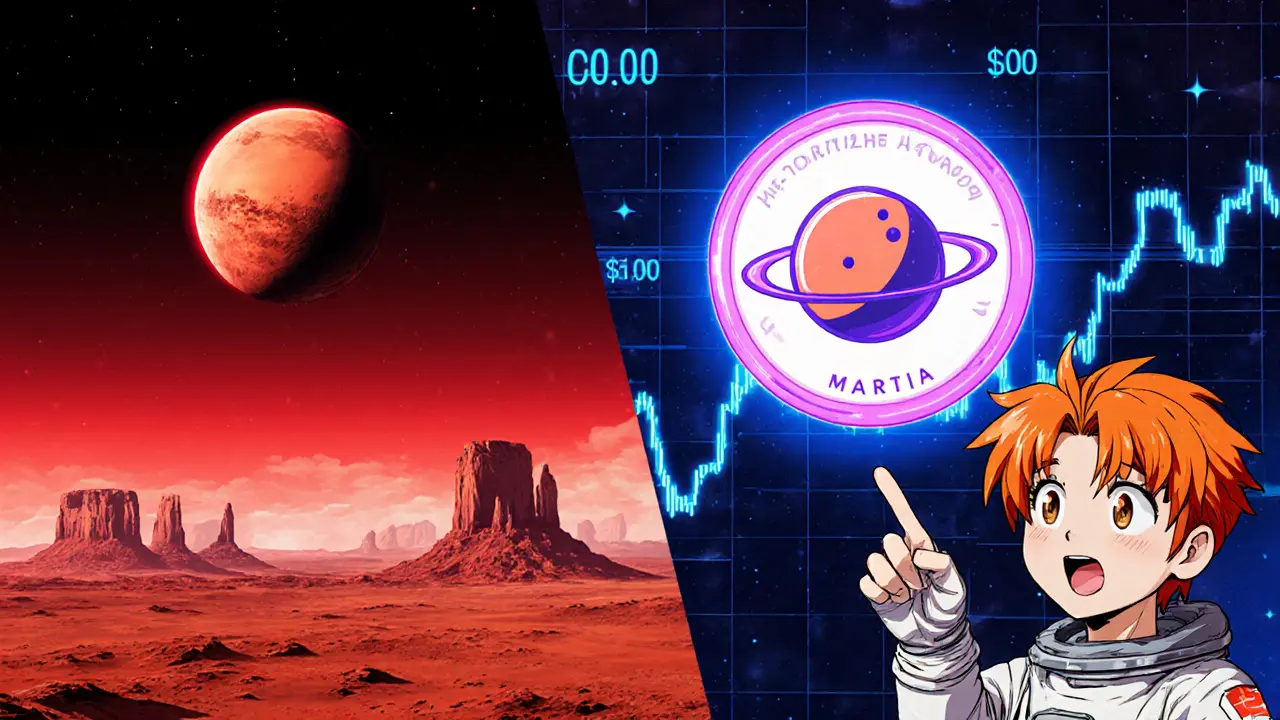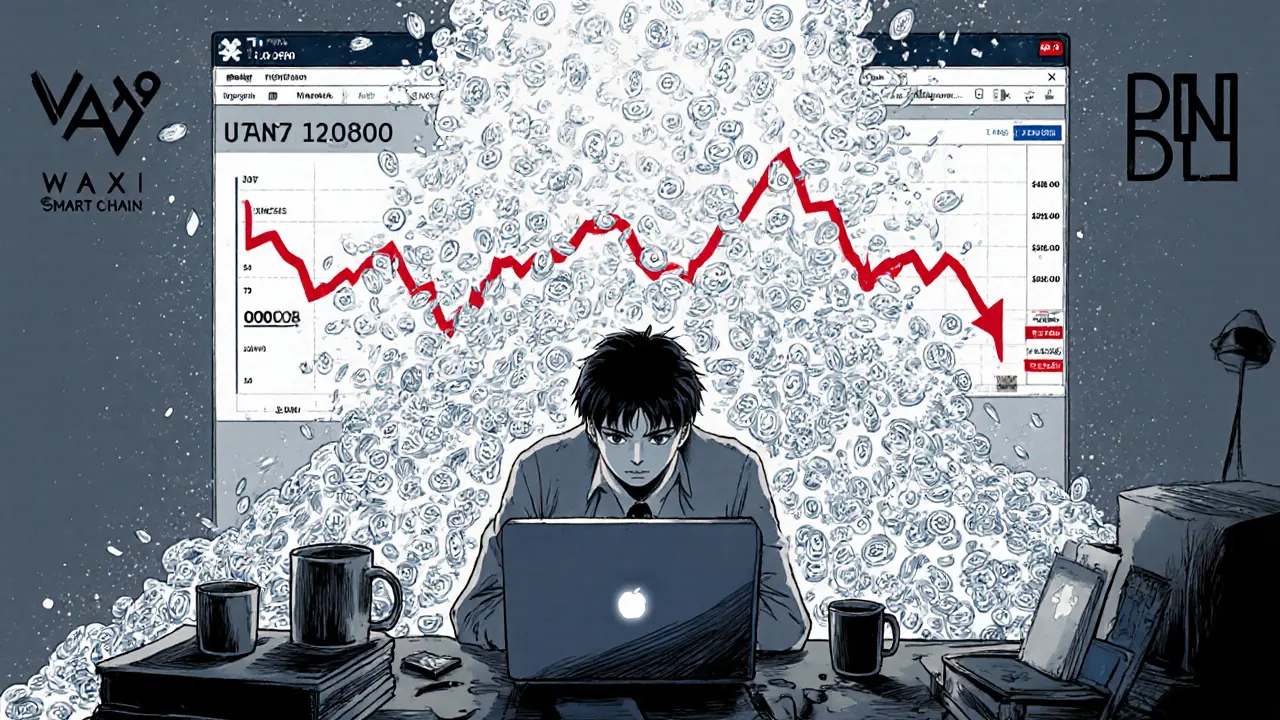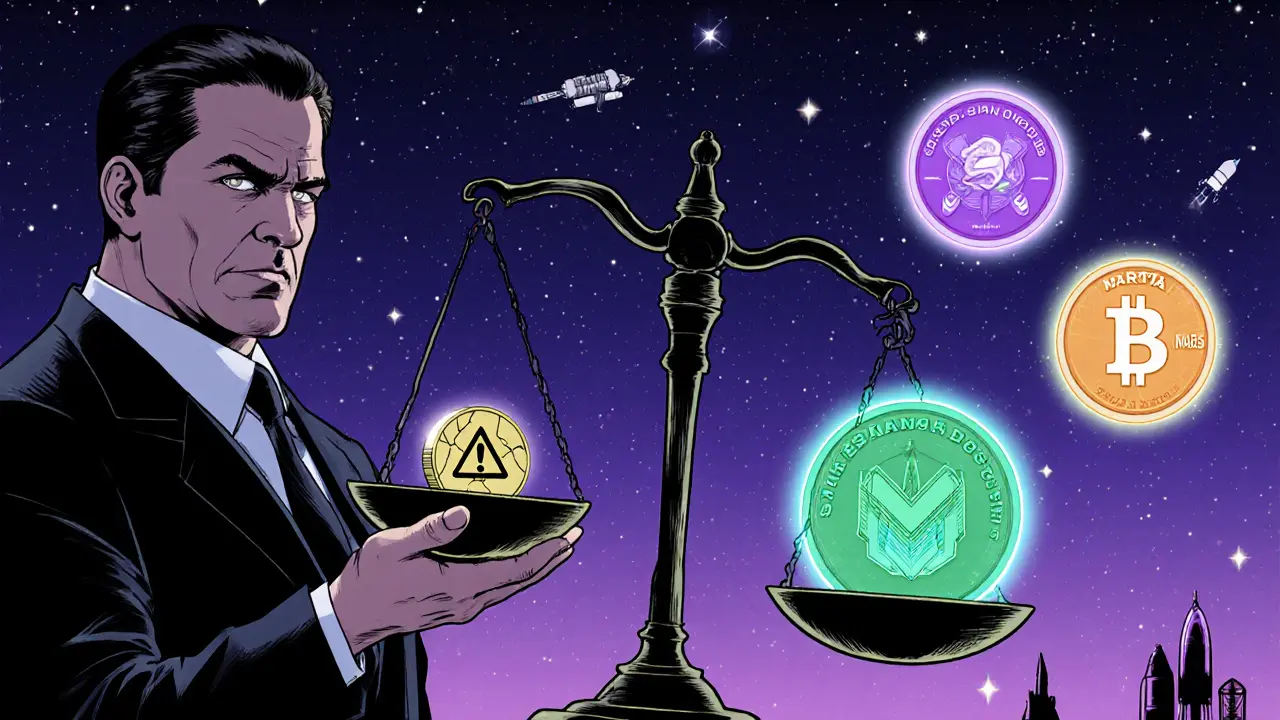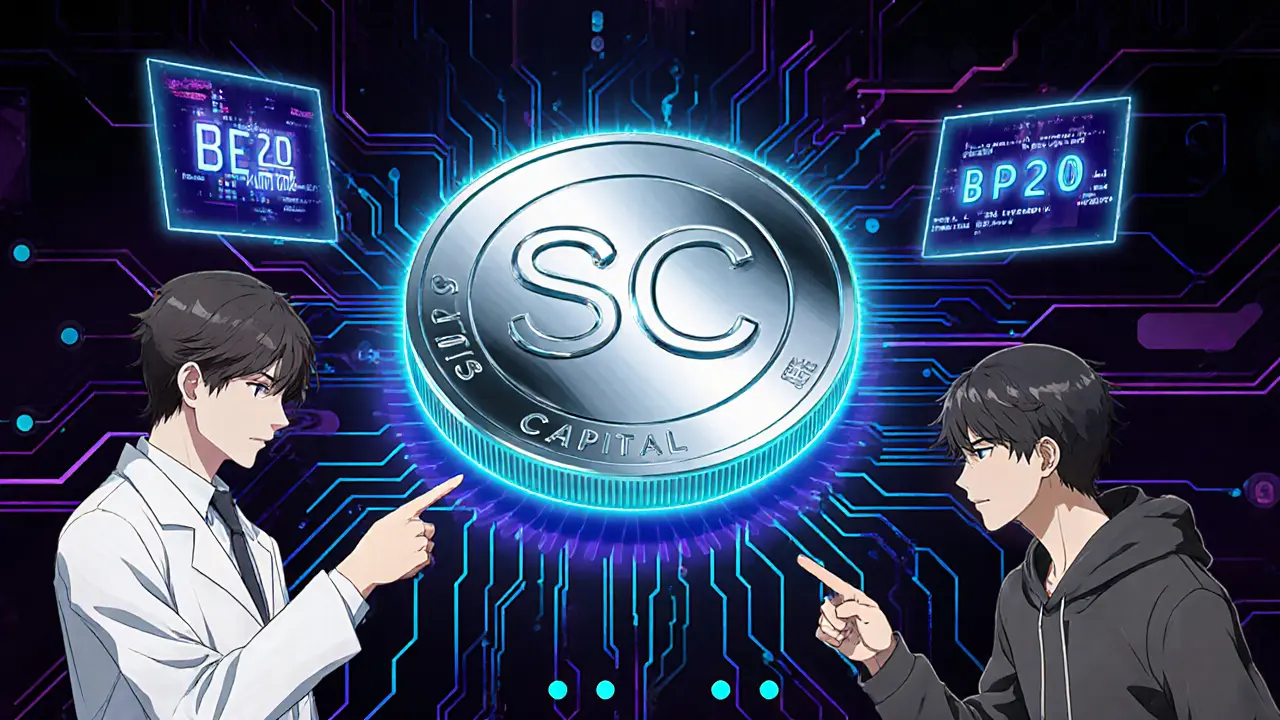Colonize Mars (MARTIA) Crypto Coin Explained - Price, Supply, and Risks

MARTIA Token Value Calculator
Calculate MARTIA Token Value
This tool calculates how many MARTIA tokens you'd get for a given amount of money at the current price. Note that due to extremely low liquidity, even small dollar amounts can represent massive token quantities.
Your MARTIA Tokens
When you stumble upon a coin named after the red planet, you probably wonder if it’s a space‑age investment or just another meme token. Colonize Mars (MARTIA) token fits the latter description - a low‑cap crypto launched in 2021, floating on the WAX blockchain and also available on BNB Smart Chain. Below you’ll get a clear picture of what MARTIA actually is, how it works, where you can trade it, and why most experts flag it as a high‑risk speculative play.
Key Takeaways
- MARTIA is a standard token on WAX and BNB Smart Chain - no unique blockchain of its own.
- Circulating supply is about 10.08 billion tokens; total supply caps at 12 billion.
- Market cap hovers around US$84 k, ranking it beyond the 7,000th spot on CoinMarketCap.
- Trading volume is effectively zero, leading to huge price slippage on any sizable order.
- No clear utility, roadmap, or partnership with real space initiatives - the token is essentially speculative.
What Is Colonize Mars (MARTIA)?
MARTIA is a cryptocurrency token that aims to capture the imagination of space enthusiasts by referencing Mars colonization. The name suggests a grand vision, yet the official documentation offers little beyond a brief description on exchange listings. Launched in 2021, MARTIA never built its own blockchain; instead, it leverages existing platforms for token issuance.
Technical Foundations
Two blockchains host MARTIA:
- WAX blockchain - a delegated proof‑of‑stake network optimized for gaming and NFTs. MARTIA appears under the simple address
martiaand follows the standard WAX token protocol. - BNB Smart Chain - a Binance‑run EVM‑compatible chain. Here MARTIA conforms to the BEP‑20 token standard, using contract
0xa4C08c4cE3a05F78f5E931673C6A45caCD4DF94C.
Because the token is a simple ERC‑20‑like asset on both chains, it inherits the same security model: custody rests with the holder’s wallet or exchange, and transaction fees are paid in the native currency of each chain (WAXP on WAX, BNB on BSC).
Supply, Price, and Market Capitalization
As of October 18 2025, MARTIA’s circulating supply stands at 10,078,963,605.2591 tokens, out of a hard‑capped total of 12 billion. The token’s price is deep in the pennies‑range, hovering around $0.0000034 USD on major platforms. This tiny price combined with a circulating supply yields a market cap of roughly $83,950, placing MARTIA well below the threshold for even a “micro‑cap” token.
Price quotes differ by exchange due to the near‑zero liquidity:
- Coinbase: $0.00000346 (+3.45% 24 h)
- Crypto.com: $0.000003379 (+1.61% 24 h)
- Binance: $0.0000030 (‑0.37% 24 h)
These discrepancies illustrate how a single trade can swing the price dramatically. The 24‑hour trading volume reported by CoinMarketCap is $0, confirming that practically no tokens change hands daily.

Where Can You Trade MARTIA?
The token is listed on a handful of exchanges, most notably:
- Binance - offers a “How to Buy Colonize Mars” guide but reports negligible volume.
- Coinbase - lists MARTIA under the gaming sector, again with almost no daily trades.
- Crypto.com - displays price data but lacks liquid order books.
Because liquidity is scarce, attempting to buy even a modest USD amount can require handling billions of tokens, which complicates wallet management and increases the chance of price slippage.
Utility - What Can You Actually Do With MARTIA?
Official sources do not describe any concrete use case. The token is categorized as “gaming” on Coinbase, hinting at potential micro‑transactions in niche games, but no integration has been publicly demonstrated. In practice, MARTIA functions like many “penny” tokens: a speculative asset with no ecosystem, no dApps, and no merchant acceptance. If a developer were to adopt it for in‑game purchases, the extreme token count required for modest prices would likely discourage any real adoption.
Risks and Red Flags
Before you consider any exposure to MARTIA, weigh these warning signs:
- Liquidity vacuum: Trading volume is essentially zero, meaning you may be unable to sell without triggering a massive price drop.
- Severe price depreciation: Over the past year the token lost 89% of its value; 30‑day, 60‑day, and 90‑day declines exceed 40%, 70%, and 60% respectively.
- Lack of development activity: No visible roadmap, whitepaper, or recent code updates; the project appears dormant.
- No credible partnerships: Unlike other space‑themed tokens such as SpaceChain or SpaceDog, MARTIA offers no verified collaboration with aerospace firms.
- Regulatory exposure: Low‑cap tokens with no utility are increasingly targeted by regulators for potential securities violations.
These factors collectively suggest that MARTIA is more akin to a gamble than an investment.

How to Acquire MARTIA (If You Still Want To)
- Create an account on a supported exchange (Binance, Coinbase, or Crypto.com).
- Complete KYC verification - required for most regulated platforms.
- Deposit fiat or a major cryptocurrency (e.g., USDT, BTC).
- Search for “MARTIA” or the contract address
0xa4C08c4cE3a05F78f5E931673C6A45caCD4DF94Con the exchange’s trading interface. - Place a limit order at the prevailing market price; be prepared for partial fills or none at all.
- If you succeed, transfer the tokens to a wallet that supports both WAX and BSC (e.g., Metamask for BSC, Anchor for WAX) to retain custody.
Remember, the price can swing by several micro‑dollars per token, so even tiny order sizes may experience large percentage changes.
Comparison With Other Space‑Themed Tokens
| Token | Blockchain | Market Cap (USD) | 24‑h Volume | Notable Partnerships |
|---|---|---|---|---|
| MARTIA | WAX / BNB Smart Chain | $84 k | $0 | None |
| SpaceChain (SCC) | Ethereum | $12 M | $1.1 M | NASA‑approved sandbox (2022) |
| SpaceDog (SPACEDOG) | Polygon | $3.5 M | $210 k | Partnership with SpaceX outreach program |
| Mars Token (MARS) | Solana | $1.2 M | $85 k | Collaboration with private Mars research consortium |
The table makes it clear that MARTIA lags far behind peers in market depth, activity, and real‑world connections. If you’re chasing a genuine space‑related crypto play, the alternatives present clearer roadmaps and community backing.
Frequently Asked Questions
What does the MARTIA token actually do?
MARTIA is a standard token on WAX and BNB Smart Chain. It currently has no documented utility, smart‑contract features, or partnerships beyond being listed on a few exchanges.
Is MARTIA a good investment?
Given its near‑zero liquidity, steep price declines, and lack of development, most analysts consider MARTIA a high‑risk speculative asset rather than a sound investment.
How can I buy MARTIA?
Create an account on Binance, Coinbase, or Crypto.com, complete KYC, deposit funds, then locate MARTIA using its ticker or contract address and place a limit order. Be prepared for possible partial fills.
What wallets support MARTIA?
For the BNB Smart Chain version, any BEP‑20 compatible wallet such as MetaMask works. For the WAX version, wallets like Anchor or Scatter are needed.
Are there any future plans for MARTIA?
Public channels show no roadmap updates, development commits, or partnership announcements as of October 2025, suggesting the project is dormant.
In short, MARTIA offers a futuristic name but little substance. If you enjoy the thrill of chasing ultra‑low‑price tokens, understand the liquidity nightmare and regulatory scrutiny that come with it. For most investors, focusing on projects with clear utility, active development, and measurable community support makes far more sense.

Marina Campenni
October 18, 2025 AT 09:04I understand why the hype around Mars‑themed tokens can be tempting, but the risks here are substantial.
Irish Mae Lariosa
October 21, 2025 AT 17:04The premise of a Mars‑colonization token sounds fanciful, yet the underlying economics are profoundly flawed; the token floats on second‑tier chains without any proprietary infrastructure, which immediately raises concerns about sustainability. Moreover, the circulating supply exceeds ten billion units, rendering any price appreciation implausible without absurd market‑cap growth. The liquidity profile is effectively nonexistent, as evidenced by the reported $0 daily volume, meaning even modest sell orders would devastate the price. Historical data shows an 89% decline over the past twelve months, a red flag that should deter any rational investor. The absence of a documented roadmap or development activity further underscores the project's stagnation; there are no recent commits on public repositories. Additionally, there are no verifiable partnerships with aerospace entities, distinguishing this token from legitimate space‑oriented projects that have secured collaborations with agencies such as NASA or SpaceX. Regulatory scrutiny is intensifying on low‑utility tokens, and MARTIA fits the profile of an unregistered security in many jurisdictions. The token’s listing on major exchanges appears to be a veneer, as order books are essentially empty, offering no genuine price discovery. From a technical standpoint, the token adheres to standard BEP‑20 and WAX protocols, providing no unique smart‑contract features that could add value. Investors seeking exposure to space‑themed assets would be better served by alternatives with clear use‑cases, active developer communities, and transparent funding. The marketing narrative relies solely on the Mars motif, which is insufficient to compensate for the fundamental deficiencies. In short, the token is a speculative gamble with a near‑zero probability of delivering returns, and it should be approached with extreme caution.
Nick O'Connor
October 25, 2025 AT 01:04Looking at the token metrics, one sees a supply of over ten billion, a market cap barely above eighty thousand dollars, and essentially no volume; consequently, any attempt to trade will encounter severe slippage, making liquidity a critical concern.
Hailey M.
October 28, 2025 AT 09:04Oh wow, another "Mars" token that promises the stars but delivers a grain of sand-talk about a cosmic letdown! 🌌🚀 The price hovers in the micro‑cent realm, and you’ll need a galaxy‑size wallet just to buy a few bucks worth. 😂 If you’re hoping for an interplanetary partnership, keep looking; the only thing this token is colonizing is the abyss of low‑liquidity chaos. 🪐💸
Schuyler Whetstone
October 31, 2025 AT 17:04People need to stop idolizin these meme‑coins, they’re nothing but a scam for the gullible, and the devs don’t even seem to give a damn about the community-just another lazy cash‑grab.
David Moss
November 4, 2025 AT 01:04Honestly, it feels like the whole crypto space is being used as a distraction from the real agendas, and tokens like this are just smoke screens-no real utility, no real backing, everything is a facade, perhaps even a coordinated effort to dilute investor capital.
Pierce O'Donnell
November 7, 2025 AT 09:04Sure, the token is cheap, but cheap doesn’t equal value; you’re basically buying an empty promise.
Vinoth Raja
November 10, 2025 AT 17:04From a systems‑theory perspective, the token lacks any emergent property that would justify its existence; it’s just a static ledger entry without any adaptive feedback loops.
Kaitlyn Zimmerman
November 14, 2025 AT 01:04For those interested in actual space‑related crypto projects, look at tokens with clear roadmaps and partnerships-those are the ones worth watching.
DeAnna Brown
November 17, 2025 AT 09:04Let me be crystal clear: this token is a textbook example of hype over substance, and anyone who’s anyone in the industry knows it’s a dead end.
Chris Morano
November 20, 2025 AT 17:04While it may look shiny on the surface, the underlying fundamentals are shaky, so proceeding with caution is advisable.
Ikenna Okonkwo
November 24, 2025 AT 01:04In the grand scheme, investing in a token without tangible utility is akin to chasing shadows-better to focus on projects with measurable impact.
Bobby Lind
November 27, 2025 AT 09:04From a risk‑management angle, the lack of liquidity and the massive supply make this token a high‑risk, low‑reward proposition.
Jessica Cadis
November 30, 2025 AT 17:04Considering the token’s negligible volume and absent roadmap, it’s clear that it doesn’t meet the criteria for a serious investment opportunity.
Katharine Sipio
December 4, 2025 AT 01:04In conclusion, investors are advised to exercise prudence and prioritize assets with demonstrable utility and robust community support.